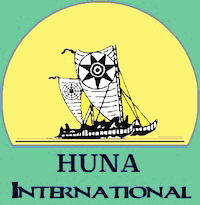Huna Article
Huna International
What Does That Mean?
by Serge Kahili King
"Knowledge must always be expressed in the lifestyle and language of each different culture for
it to be accepted and believed." This is a statement by Dr. J.R. Worsley in regard to
acupuncture, but it can be applied to any other field as well.
Just recently I was counseling a woman from India who had been living in California since her
youth. A while before calling me she had consulted an Indian guru who had advised her to read
the fifteenth chapter of the Bhagavad Gita, a Hindu holy book. The woman read the chapter over
and over, but was completely confused because she didn't know what she was supposed to learn
from it. She understood that it was about non-attachment, but it kept talking about a banyan
tree, and although this woman was originally from India, she had never seen a banyan tree, so
the metaphor made no sense to her.
At first I tried to explain what a banyan tree was so she could understand it, but with no
memory to relate to it still didn't make sense. Then I switched metaphors, first using an
example of rain, then of a mirror, both of which she'd had experience with, and both of which
enabled her to understand what the book was really teaching. What she had to learn is not
important here. The point is that in order for her to learn the lesson, the knowledge had to be
"expressed in the language and style" of her existing culture for it to be accepted and
believed.
I just read a Dilbert cartoon in which he tries to explain to his mother that he is neither a
railroad engineer nor a typewriter repairman, but a software engineer. When she asks him what he
does, he says something like "Well, today I debugged a TCP/IP network with a system analyzer,"
and she replies with something like, "You mean all you did was start a bot to search out bad
packets?" The fact that she knew immediately what he was talking about was quite funny,
especially since she knew that he was using "computerese" to cover up the fact that he really
didn't do very much. It was even funnier IF the reader also knew the special language of
computer geeks. On the other hand, as far as my wife was concerned the cartoon might as well
have been written in ancient Sanscrit and she couldn't understand why it made me laugh.
Like many fields and systems, Huna has its own specialized terms, based on the Hawaiian
language, but when trying to relate to people unfamiliar with Hawaiian or Huna we need to use
words and descriptions that nearly everyone can grasp. Remember, one of our purposes is to strip
away the veil of unneeded mystery from the things we are teaching.
Those of us who are teachers of Huna often take it for granted that other people already know
what we mean when we use terms like "Lono," and "Ku," and " Aumakua,"
and we may get so involved in our teaching that we ignore the blank faces in front of us. And
shockingly--to us--there are millions of people out there in the world who haven't the faintest
idea of what we are talking about when we mention "The Aloha Spirit."
The point of all this is that communication is not merely the imparting of information, it is
the exchange of information. The exchange does not always have to be verbal, however. It can
also be in the form of behavior. If you teach someone a healing technique, and the person is
able to apply the technique in the way you have taught, then the behavior of that person is
their part of the communication exchange. If the person is unable to apply it, then it is up to
the teacher to change his or her side of the communication. In a different, but related field,
someone whose name I do not recall once said, "There is no such thing as a resistant client;
there is only a therapist who doesn't know what to do."
Copyright Huna International 2007

|

